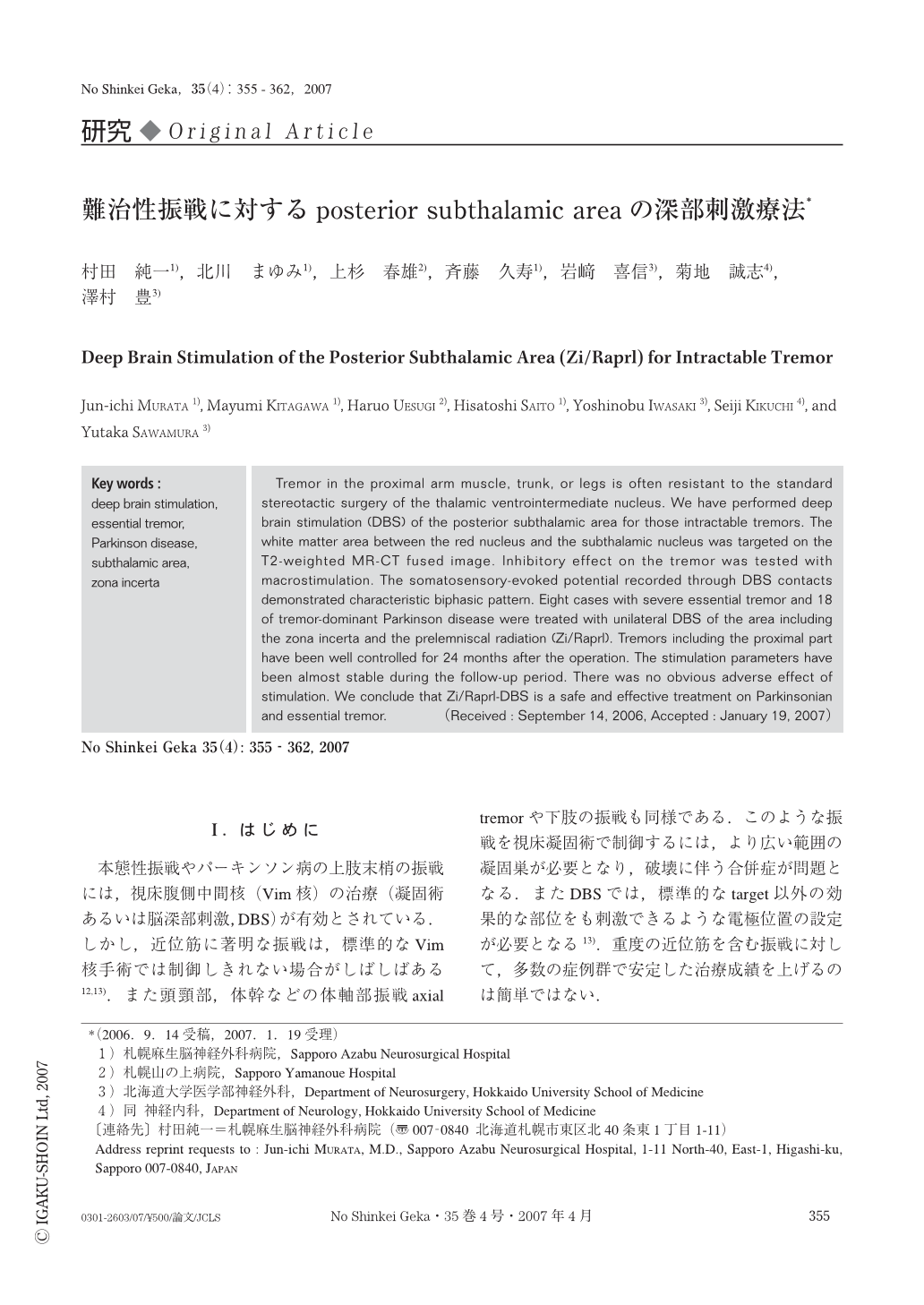- 著者
- 村田 純一 北川 まゆみ 上杉 春雄 斉藤 久寿 岩㟢 喜信 菊地 誠志 澤村 豊
- 出版者
- 医学書院
- 雑誌
- Neurological Surgery 脳神経外科 (ISSN:03012603)
- 巻号頁・発行日
- vol.35, no.4, pp.355-362, 2007-04-10
Ⅰ.はじめに 本態性振戦やパーキンソン病の上肢末梢の振戦には,視床腹側中間核(Vim核)の治療(凝固術あるいは脳深部刺激,DBS)が有効とされている.しかし,近位筋に著明な振戦は,標準的なVim核手術では制御しきれない場合がしばしばある12,13).また頭頸部,体幹などの体軸部振戦axial tremorや下肢の振戦も同様である.このような振戦を視床凝固術で制御するには,より広い範囲の凝固巣が必要となり,破壊に伴う合併症が問題となる.またDBSでは,標準的なtarget以外の効果的な部位をも刺激できるような電極位置の設定が必要となる13).重度の近位筋を含む振戦に対して,多数の症例群で安定した治療成績を上げるのは簡単ではない. Posterior subthalamic areaは,古くから定位脳手術の有望なtargetとして認知されており,1960年から1970年代に術中電気刺激または凝固破壊で,近位筋を含む多様な振戦に著効を示した多くの報告がある2,10,20,21).しかし破壊に伴う合併症が問題となり広く普及するには至らず,代わって視床Vim核手術が標準的治療となっていった14).しかしながらDBSが普及した現在,この領域は十分安全に治療可能なtargetである.ここはSchaltenbrand and Wahrenのatlasでは,不確帯(zona incerta, Zi)とprelemniscal radiation(Ra.prl.)からなる(以下,Zi/Raprl). 筆者らは,Vim thalamotomyで遠位筋振戦は消失したが近位筋振戦が改善しなかった本態性振戦の症例で,Zi/RaprlのDBSが著効した例を経験した.その後,振戦を主徴とするパーキンソン病にも同治療を試み,振戦ばかりでなく固縮・寡動にも有効であったため,症例を重ねて長期的に持続する効果を得ている.本稿では,その治療手技および長期効果を報告したい.
1 0 0 0 OA 特異なdraining veinを有した前頭蓋底部硬膜動静脈奇形の1例
- 著者
- 鐙谷 武雄 上山 博康 村田 純一 布村 充 蝶野 吉美 小林 延光 阿部 弘 斉藤 久寿 宮坂 和男 阿部 悟
- 出版者
- 日本脳神経外科学会
- 雑誌
- Neurologia medico-chirurgica (ISSN:04708105)
- 巻号頁・発行日
- vol.27, no.12, pp.1195-1200, 1987-12-15
- 被引用文献数
- 6 12
A case of dural arteriovenous malformation (AVM) in the anterior cranial fossa is reported. A 61-year-old male was hospitalized because of sudden onset of severe headache, vomiting, mild hemiparesis, and lethargy. Computerized tomography disclosed left frontal subcortical and fronto-temporal subdural hematomas. Angiography revealed an AVM in the anterior cranial fossa, fed by the bilateral anterior ethmoidal arteries and drained by the left olfactory and left fronto-orbital veins. The latter veins had large, varicose dilatations and drained to the basal vein of Rosenthal. Two weeks after artificial embolization, surgical evacuation of the hematoma and removal of anomalous vessels, including a varicose dilated vein, were carried out. The involved dura at the olfactory groove was coagulated rather than totally removed. According to literature, the dural AVM in this region is fed primarily by the anterior ethmoidal artery and drains via the leptomeningeal veins into the superior sagittal sinus. Varicose dilatation of a draining vessel is considered a characteristic angiographical finding. The high incidence of bleeding from dural AVMs in this region is related to the varicose dilatation. The drainage capacity of the elongated leptomeningeal veins is insufficient, and the high arterial pressure in the AVM leads to the development of varicose dilatation and intracranial hemorrhage.

